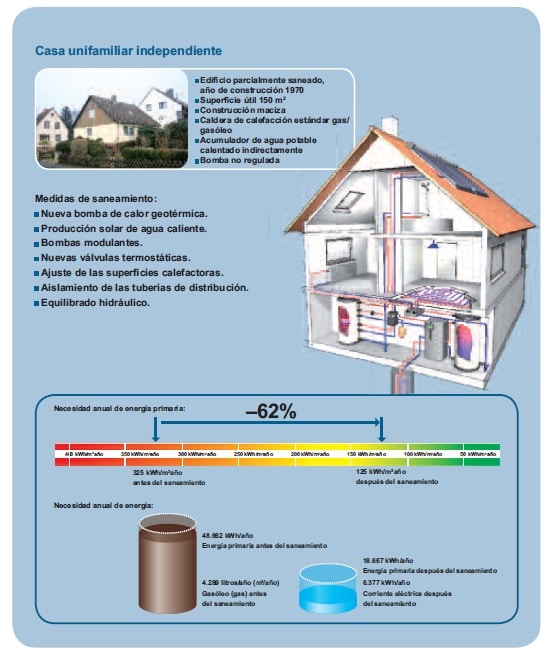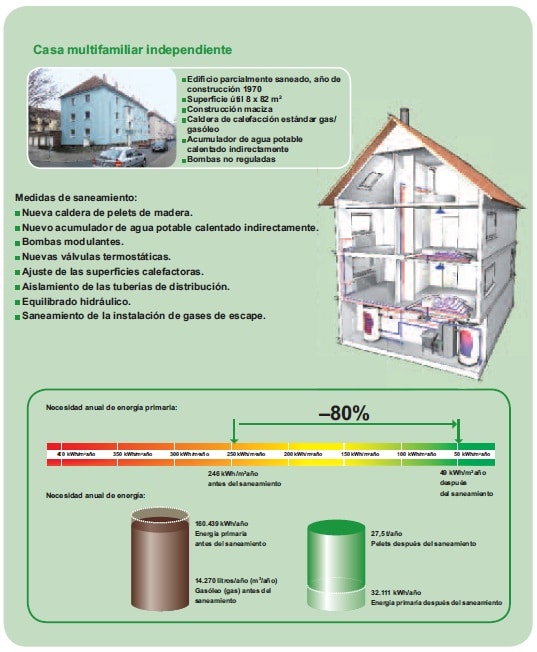-
Phone Number
-
Email Address
When it comes to proposing solutions to improve the rehabilitation of existing buildings we are already conditioned by a series of design parameters pre-established, and there probably has not been a maximum use of these parameters to reduce their demand and optimize the energy efficiency of the home, especially in older ones.
The rehabilitation should be analyzed in depth of old buildings that we intend to improve. Assessing which are the most possible proposals for improvement appropriate, through a thorough analysis of the savings energy and environmental benefits that would be achieved with the implementation of each measure as well as an economic study that allows us to evaluate its viability and amortization.

Proposals for improvement of a property to rehabilitate , go through increasing the isolation thermal of all the elements of the envelope temperature of the house, reduce existing thermal bridges trying to eliminate possible pathways or foci where they could exist condensation humidity as well as trying to adapt or apply certain passive systems to the building and implement renewable energy or efficient facilities, some proposals would be the following:
Content menu:
Normally in facades to rehabilitate we incorporate insulation panels inside, systems SATE on the outside or projecting thermal insulation in the air chambers.
If the lining is done on the outside, it would be the best option since it is possible to eliminate all thermal bridges and the appearance of condensation on the enclosure is avoided, while, if it is done from the inside, we will obtain worse results because, although it improves the thermal transmittance of the enclosure, can leave areas with thermal bridges and allow the appearance of condensation.
In the case of dwellings located below deck, the can improve the thermal transmittance of the roof incorporating thermal insulation, in the same way if we We are in a house on the ground or first floor on a non-heated premises or garages, we could incorporate it into the forged or horizontal separation element with it.
In principle if we find a window with a simple glass the first option will be to replace it with a climalit, trying to provide those solutions that offer lower thermal transmittance, in principle those that They have a thicker air chamber. other solutions would be:
An article of interest in glazing is that of types of exterior enclosures and glass classification by have more specific information on this section.
The most suitable areas and where you can lose the most amount of heat are normally the pillar encounters with facade and especially in old buildings already that, in many cases, the inside face of the pillar is seen without no type of lining, or if there is insulation it can be interrupted against the lateral faces of the column, the perimeter of the windows, (lintels and jambs), as well like shutter drawers.
Another weak point are the covers, which must be applied different factors to study and that are treated in detail from the roof rehabilitation article with tips and manuals of interest.
So that in this way you can achieve greater comfort without input of heat or cold and thus reduce consumption energetic.
In this case, as it is an existing building, the largest energy savings will be achieved by improving the efficiency of the facilities , given that there is a greater limitation when it comes to reducing demands of the home or building, equally if we managed to cover the energy demand by providing energy renewable. Our goal will be to jointly implement those teams that are as efficient as possible together with renewables to minimize energy consumption and improve the rating. Some efficient systems will be the following:
Regarding facilities, we have one more article where the equipment and systems are studied in detail of air conditioning in a house with its characteristics in depth and functions.
Next we are going to add some specific cases to improving the energy efficiency of houses second-hand in which the measures of improvement cited above, drawn from the interesting guide «efficient air conditioning systems and energy use Renewables» published by the Association of Manufacturers of Generators and Heat Emitters for Hot Water (FEGECA), being the following.
We attach a series of sheets detailing the specific points of study on which action is taken in benefit of improving the rehabilitation of houses .




Although not discussed in this section, vegetation in buildings and their facades is a regulatory contribution that benefits construction as a whole and really should be consider your application.
We can test that there are many subsidies for the rehabilitation of old houses and the best thing is consult them from the IDAE itself in the aids and financing in the area HERE. Where will we find the sections of:
Keep in mind that aids for home rehabilitation are normally in short supply in Spain (even many times from the European Union are best) and on the other hand there are always those of the Autonomous Communities and even provinces where it is better consult directly from the local administration or the town hall where the properties belong to rehabilitate .
If you liked the article, rate it and share!